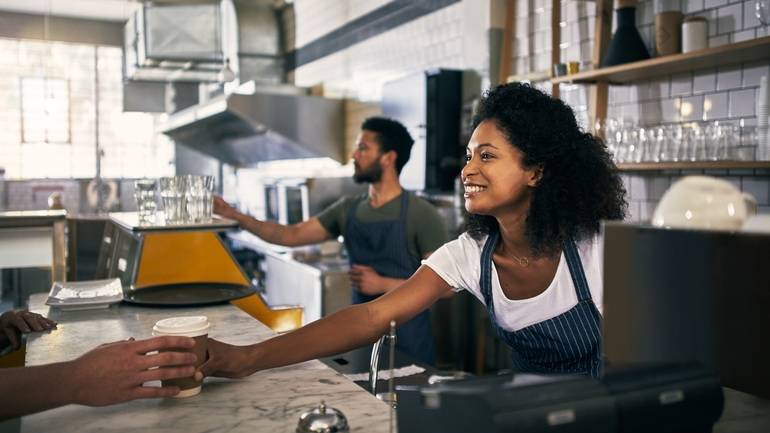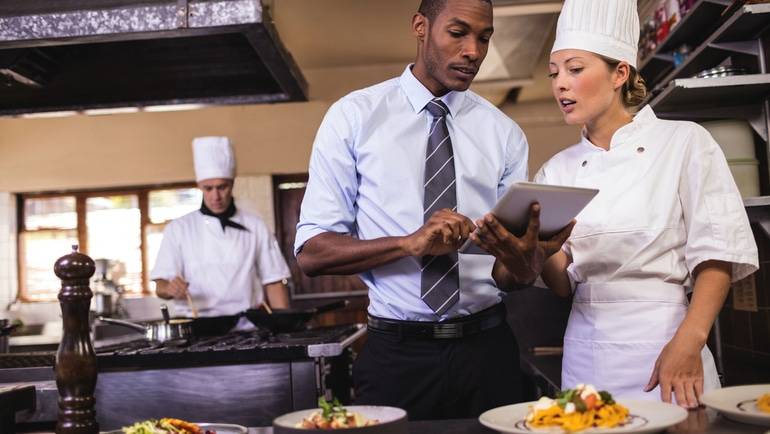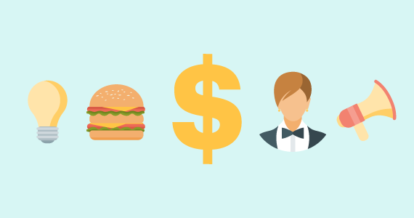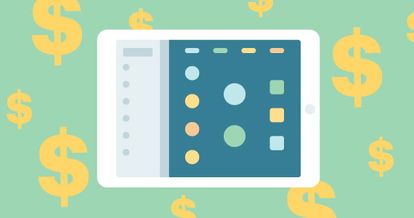Running a restaurant isn’t cheap – operating costs add up fast.
In addition to the massive investment that comes from simply opening your doors, there’s also those ongoing operating costs to contend with. From fluctuating food prices to minimum wage hikes, cost management is a skill that restaurateurs have to master if they (literally) want to keep the lights on.
Luckily, you don’t need a background in finance to keep your books balanced – although any accountants-turned-restaurateurs might have a bit of an advantage. In reality, all you need to know is how to run a few simple calculations.
To help you understand where your money is going and how to spend it wisely, we’ve created a handy guide to restaurant operating costs, which covers:
- The difference between fixed costs, variable costs, and semi-variable costs
- The three biggest restaurant operating costs
- Different strategies you can employ to keep costs to a minimum
- How to calculate your own operating costs
An Introduction to Restaurant Operating Costs
Restaurant operating costs are the costs you incur in the day-to-day process of running a restaurant. Each of these three restaurant costs can be categorized as a fixed cost, variable cost, or semi-variable cost.
- Fixed costs are costs that largely stay the same month-to-month because they are not tied to sales. Rent falls under the category of a fixed cost.
- Variable costs change according to output, which means they are less predictable and harder to budget for. Food is an example of a variable cost.
- Semi-variable costs are composed of both fixed costs and variable costs. In a restaurant, labor is often considered a semi-variable cost because you have both salaried employees (a fixed cost) and hourly employees (a variable cost).
When you add up all of your fixed costs, variable cost, and semi-variable costs, you get the total operating costs for your restaurant.
However, this number only shows you part of the picture.
Imagine if you only looked at the amount due on your credit card each month. While this number shows you what you owe, it doesn’t give you much insight into where your money went – you could have wasted $200 on luxury candles! So if you’re trying to control your spending, you need to look more closely at what you actually bought.
It’s the same idea with your restaurant operating costs. In order to fully understand where your money is going, you need to dive into each category of expenses. Once you know exactly where your costs are out of control, you can start making changes to tackle those costs.
Below, we’ll dive into the three biggest restaurant operating costs:
- Labor
- Food
- Rent
We’ll also cover different strategies you can use to keep those costs down before explaining how to calculate your own operating costs.
1. Labor Costs
If you think of your restaurant operating costs as a pie, labor often accounts for the biggest slice. Your total labor costs not only include hourly wages and salaries, but also associated costs such as payroll taxes, overtime, bonuses, vacation pay, sick days, and employee benefits.
To find out if you’re spending too much (or too little) on labor, you can calculate your labor cost percentage:
(total labor costs for the period ÷ total sales for the period) x 100 = labor cost percentage
To illustrate this, we’ll use the example of Caroline and her adorable French bistro, Maison Rouge.
Caroline’s total labor costs for April were $18,000. After checking her POS system, Caroline sees that her total sales were $50,000 for the period. Caroline’s formula would look something like this:
($18,000 ÷ $50,000) x 100 = 36%
Therefore, her labor cost percentage would be 36%.
For Caroline, this number is cause for concern because most restaurants aim to keep their labor cost percentage below 30%.
But Caroline is not alone. According to a recent study by BDO, the average labor cost percentage across all types of restaurants has risen to 31.6%.
This increase can partially be attributed to the rise of minimum wage and tipped minimum wage in many states. In fact, more than 20 states are updating their minimum wage rates in 2020.
Additionally, restaurants must also contend with a shrinking pool of potential workers. With the jobless rate in the U.S. less than 4%, it’s becoming harder and more expensive for restaurants to find, train, and retain talent. In fact, our 2025 State of Restaurants Report reports that operators spend $3,560 on average to train a new employee.
With labor accounting for such a significant portion of a restaurant’s operating costs, these challenges mean that many restaurants are looking for creative ways to reduce their labor costs.

Reducing Labor Costs
Like Caroline, your labor cost percentage may be a bit too high for your liking. Naturally, your first instinct is probably to schedule less staff.
Not so fast!
Cutting staff can actually harm customer service and eventually lower sales, which is not the outcome you want.
Before you start cutting down on scheduled staff, you might want to consider using the following strategies to reduce your labor cost percentage:
- Boost Employee Retention: The restaurant industry has a notoriously high turnover rate, and it’s more expensive to hire new employees than to retain old ones. Therefore, invest in your existing employees by offering incentives for good performance or providing opportunities for growth to keep them with you longer.
- Schedule Smarter: Many restaurants rely on manual schedules that are time-consuming and prone to error. By using data from a POS system and a scheduling software, you can plan your schedule more efficiently and avoid costly mistakes.
- Improve Employee Efficiency: Improperly trained staff can cost your restaurant in more ways than one. Make sure all staff receive proper training right from the start and consider cross-training staff so they can carry out different roles when necessary. A more efficient staff means you can operate with a leaner workforce without sacrificing customer service.
- Think Outside the Box: Many restaurants employ staff to carry out functions that can increasingly be done by technology. If you’re looking to save on labor costs, adding self-ordering kiosks or mobile applications can help you do more with less staff.
2. Food Costs
In addition to labor, food costs are another major part of the operating costs pie.
Unfortunately, food costs can vary wildly due to a number of different factors. For instance, something as simple as bad weather can drive up the cost of certain ingredients. Other times, prices can change due to the popularity of an ingredient – just think of the recent obsession with avocados.
And it’s not just the price of ingredients that can impact your food costs. Many restaurants also struggle to keep food costs low due to internal waste. In fact, TouchBistro’s 2019 Restaurant Report found that 58% of restaurateurs struggle to properly manage their inventory and end up ordering too much food. This translates into wasted ingredients and wasted dollars.
As a result, it’s important to keep a close eye on your food costs, so you can set appropriate menu prices and know when you need to raise those prices. The best way to do this is to calculate your food cost percentage.
Your food cost percentage reveals how much your restaurant’s sales are dedicated to your menu ingredients. This probably sounds like a fairly straightforward metric, but it’s a bit more complicated than you might think.
Every restaurant is different, with the average food cost percentage falling anywhere between 20 to 40%. For instance, a steakhouse may have a food cost percentage of 38% because of the reliance on premium ingredients, while a restaurant that uses cheaper ingredients, like bulk pasta, may be closer to 25%.
To find out your own food cost percentage, you can use two different methods:
- Calculate the plate cost of a single dish by measuring each ingredient
- Calculate the period cost by using your Cost of Goods Sold (CoGS)
Though calculating plate cost can be done, it’s a tedious process that is not necessarily accurate because it doesn’t take into account how much product you have in inventory. Therefore, using CoGS can be a better way to track your food cost percentage.
But what is CoGS and how do you find this number? Your CoGS is the cost of the raw materials (food and beverages) needed to produce your menu items. You can calculate CoGS by using the following formula:
[the food and beverages inventory you start with] + [the amount of food and beverages purchased] – [the food and beverages inventory left] = CoGS for the period
You can then calculate your food cost percentage using your CoGS with the following formula:
(CoGS for the period ÷ total sales for the period) x 100 = food cost percentage
Back to Caroline and Maison Rouge. Her CoGS for April was $10,000 and her sales were $50,000. Caroline’s calculation would look like this:
($10,000 ÷ $50,000) x 100
This means her food cost percentage is 20%, which is great by industry standards.

Reducing Food Costs
Although Caroline is doing a good job keeping her food costs under control, you might be wondering how to keep your own food costs down. Luckily, there are a number of simple strategies you can employ:
- Improve Inventory Management: Using an inventory management system or tracking things closely with a spreadsheet can help you determine ingredient-level food costs and price your menu accordingly.
- Get Friendly with Your Suppliers: Build relationships with multiple suppliers so you can find the best market price for the ingredients you need.
- Change with the Seasons: Keep an eye on the price of seasonal ingredients and make sure your prices fluctuate accordingly.
- Go High-Low with Your Menu Pricing: Ensure your menu is made up of a mix of high-cost and low-cost items to control ingredient costs on your end while giving customers a sense of variety.
- Minimize Waste: Reduce the amount of food that ends up in the bin by employing green tactics such as reducing portion sizes and finding creative ways to reuse food scraps.
3. Rent
Though food and labor account for the lion’s share of your operating costs, there is one more major operating cost to consider: rent.
Rent and utilities alone account for about 5 to 10% of a restaurant’s monthly sales, meaning these costs can have a major impact on your profitability.
And for many restaurants, the cost of rent is becoming a growing concern. In most major urban hubs, restaurateurs face sky-high commercial rent prices for high-foot traffic areas. Even restaurateurs who take a chance on less desirable neighborhoods often find themselves priced out of the neighborhood just a few years later due to the revitalization that they helped to put in motion. In short, rent is a part of your operating budget that you can’t afford to ignore.
Reducing Rent
Though rent is an inevitable expense (unless you own your space, in which case you’re paying a mortgage), there are some innovative strategies you can employ to shrink that number:
- Renegotiate Your Lease: If you’re on a month-to-month lease, talk to your landlord about renegotiating the terms of your lease. If you commit to staying longer, you may be able to lock in a long-term lease that can protect you against future rent increases.
- Sublease Your Space: Instead of letting your restaurant sit idle outside of business hours, you might consider subleasing the space to food trucks, catering companies, or pop-up restaurants that can use your kitchen.
- Consider Downsizing: In some cases, you can save money on rent by finding a smaller location and using the space in creative ways, such as setting up counter seating or partnering with mobile takeout apps.

How to Calculate Your Restaurant’s Operating Costs
Now that you have a better understanding of the kinds of costs involved in running a restaurant, we’ll show you how to run your own numbers and find out where your hard-earned dollars are going.
As mentioned above, your restaurant’s operating costs are the sum of your fixed costs, your variable costs, and your semi-variable costs. Again, we’ll use the example of Caroline and her little French bistro to explain how to calculate this figure.
Fixed Costs
Caroline has run the numbers and drawn up a list of her monthly fixed costs. To keep things simple, we’ll consider utilities as a fixed cost in this scenario.
Rent: $7,000
Taxes: $2,000
Equipment: $2,300
Utilities: $3,000
Maintenance: $500
Marketing: $200
Total Fixed Costs: $15,000
Variable and Semi-Variable Costs
We now know Caroline’s fixed costs, but what about her variable costs and semi-variable costs?
Food is the biggest variable cost for restaurants and labor is the biggest semi-variable cost. Both of these costs can be calculated by using the prime cost formula. This formula calculates the sum of labor costs and CoGS.
To calculate your prime costs, you can use the following formula:
CoGS + total labor costs = prime cost
Once you have your CoGS (which we reviewed earlier), labor costs can be tallied with the following formula:
[total amount spent on salaries] + [total wages of hourly workers] + [overtime, bonuses, payroll taxes, health care, etc.] = total labor costs for the period
We know that Caroline’s CoGS is $10,000 and total labor costs are $18,000 for the month of April. With this information we can calculate her prime cost.
$10,000 + $18,000 = $28,000
We now know that Caroline’s prime cost is $28,000.
To find Caroline’s total operating costs, we’ll add her prime cost to her fixed costs from earlier.
$28,000 + $15,000 = $43,000
The above reveals that Caroline is spending $43,000 per month in operating costs. This means that in order to breakeven, Caroline’s sales must be at least $43,000.
But don’t forget, this exact figure is less important than making sure you’re keeping an eye on those big operating costs we covered: food, labor, and rent.
Though controlling your operating costs can be tricky, it’s an essential part of running a restaurant. Keeping an eye on key calculations such as prime cost, labor costs, and food costs not only gives you an idea of where your money is going, but it also lets you know when you need to reign things in so you can stay out of the red.
Download our free inventory template
Sign up for our free weekly TouchBistro Newsletter







